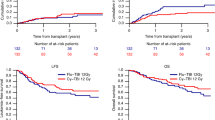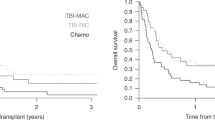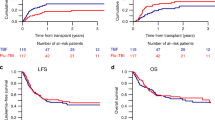Abstract
High-dose therapy and allogeneic matched sibling bone marrow transplantation (BMT) is considered to be the treatment of choice for children with relapsed acute lymphoblastic leukemia (ALL), or for children with acute myeloid leukemia (AML) in first remission. However, the rate of bone marrow relapse after transplant for either of these diseases remains high. In this study, we assessed the efficacy and toxicity of high-dose cytosine arabinoside and total body irradiation (TBI) followed by allogeneic BMT, for children with acute leukemia or myelodysplastic syndrome (MDS). Sixty-five pediatric patients underwent allogeneic related (n = 57) or unrelated (n = 8) BMT. Twenty-seven were transplanted for ALL in second remission (CR2), and 16 for AML in first remission (CR1). The other 22 were high risk patients: six were transplanted for ALL in third remission (CR3), two for AML in CR2, two for myelodysplastic syndrome (MDS) and 12 for acute leukemia in relapse. Patients were prepared with cytosine arabinoside 3000 mg/m2 per dose twice daily for 6 days followed by 1200 cGy TBI as 200 cGy fractions twice daily for 3 days. Minimum follow-up is 21 months. Five-year event-free survival (EFS) and the actuarial relapse rate is 59 and 14% for patients with ALL in second remission, and 38 and 14% for patients with AML in first remission. Twelve patients have relapsed (three are alive in remission after testicular or marrow relapse) and 28 have died of other causes. Acute GVHD with or without infection was the cause of death in 11 patients. Ten of the 11 patients who died of acute GVHD were considered at ‘high risk’ for GVHD (inadequate GVHD prophylaxis, or mismatched family donor or a matched unrelated donor). Toxicities in the immediate post-BMT period included diarrhea, oropharyngeal mucositis and conjunctivitis. Significant late toxicities included short stature, avascular necrosis of bone, and poor school performance (most often in patients who had received prior cranial irradiation). Our conclusions are that high-dose Ara-C and TBI followed by allogeneic bone marrow transplantation is effective therapy for children in second complete remission of their acute leukemia. However, significant late toxicities occur, and it is clear that more effective, less toxic therapies are necessary for these patients.
This is a preview of subscription content, access via your institution
Access options
Subscribe to this journal
Receive 12 print issues and online access
$259.00 per year
only $21.58 per issue
Buy this article
- Purchase on Springer Link
- Instant access to full article PDF
Prices may be subject to local taxes which are calculated during checkout
Similar content being viewed by others
Author information
Authors and Affiliations
Rights and permissions
About this article
Cite this article
Gordon, B., Warkentin, P., Strandjord, S. et al. Allogeneic bone marrow transplantation for children with acute leukemia: long-term follow-up of patients prepared with high-dose cytosine arabinoside and fractionated total body irradiation. Bone Marrow Transplant 20, 5–10 (1997). https://doi.org/10.1038/sj.bmt.1700827
Received:
Accepted:
Issue Date:
DOI: https://doi.org/10.1038/sj.bmt.1700827
Keywords
This article is cited by
-
A modified busulfan and cyclophosphamide preparative regimen for allogeneic transplantation in myeloid malignancies
International Journal of Clinical Pharmacy (2015)
-
High-dose cytosine arabinoside and etoposide with total body irradiation as a preparatory regimen for allogeneic hematopoietic stem-cell transplantation in patients with acute lymphoblastic leukemia
Bone Marrow Transplantation (2004)
-
Antileukemic and long-term effects of two regimens with or without TBI in allogeneic bone marrow transplantation for childhood acute lymphoblastic leukemia
Bone Marrow Transplantation (2004)
-
Using peripheral blood progenitor cells (PBPC) for transplantation in pediatric patients: a state-of-the-art review
Bone Marrow Transplantation (2000)



